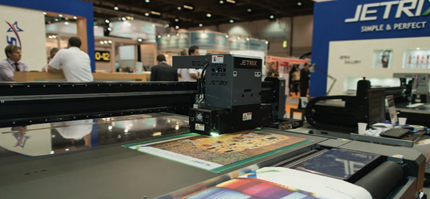Nessan Cleary gets up close to this new flatbed, launched complete with new inks at Fespa 2013.
Korean ink manufacturer Inktec showed a flatbed printer at this year’s Fespa show in London. The Jetrix KX5 has a bed size of 2.5 x 1.3m, and there’s an optional roll-feeder which takes media up to 2.2m. This should take rolls up to around 100m, enough to allow the printer to be left printing during the night. Unusually, it will take media up to 10cm high. The operator has to set the carriage height but there’s a motion sensor on either side that will stop printing if there’s any danger of the heads hitting the substrate.
It has a fairly solid stainless steel honeycomb structure, which weighs around two tons and will take substrates up to half a ton. Ben Woodruff, sales manager for Inktec Europe, says that the bed is flat to within a 0.2mm tolerance once it’s been set up. It can be recalibrated though there doesn’t seem to be anything to warn users if the bed does need recalibrating.
The KX5 replaces the earlier Jetrix 2513, which used Dimatix Q-class printheads. This new printer has Konica Minolta 1024 printheads, which Woodruff says are faster and give better resolution, thanks largely to having a fixed six picolitre drop size. Woodruff expects that most customers will use the Quality mode, which has 1440 x 720dpi resolution and runs at 20m2/hr. But there’s also a Fine Art mode at 1440 x 1440dpi that runs at 10m2/hr and a Production mode that can reach 30m2/hr but at a resolution of 1440 x 360dpi.
Woodruff says that the heads should last for at least three years, depending on how well they are maintained, which essentially means keeping dust and dirt away from them. Each colour can be purged individually. The machine itself takes around five minutes to warm up in the morning.
Of course Inktec is primarily an ink manufacturer and as such has naturally has developed an inkset specifically for this printer. The inks contain a universal primer that, according to Woodruff, give “very strong adhesion to hard to print items like glass, acrylic and Correx”. Furthermore, he says that it’s flexible enough not to crack on rigid substrates when routed, and it can be printed to the usual roll media such as PVC and wall coverings.
The basic model is a CMYK printer, but there’s an option to add white and varnish. Woodruff says that Inktec is also looking at adding other colours such as orange and green to extend the colour gamut. The white ink is used in two channels so it doesn’t slow the printer down, and the ink is kept recirculating within the heads as is usual with white inks.
Operators can determine the finished texture of the inks, depending on whether the UV lamps are set to Full, for a matte finish, or to Half, for a satin effect, or to Reverse, which gives a gloss effect as the lamps only cure in one direction.
It can print three layers in one pass, and up to 36 layers in total, not that most people would want to. But some retail window applications require seven layers so it’s a useful feature.
There’s a choice of Caldera or Onyx Rips, though Woodruff says that both Inktec and its dealers are better set up to support the Onyx Rip, adding: “The functionality seems a bit more in depth for it.”
The basic four-colour machine starts at £85,000. This rises to £93,000 if you include the white and varnish, which Woodruff expects most customers will. Add in the roll-fed option and it’s £98,000. However, the price does include delivery, installation and training. There’s a further £12,000 warranty, which will also cover the printheads.
The inks are around £96 a litre (£105 for the white), though as with most vendors, this price largely depends on the volume used. Woodruff claims that it costs 50p per square metre at the 720dpi Quality setting. This is based on an average of 5-6ml per square metre on average, which would make for relatively low ink consumption.


